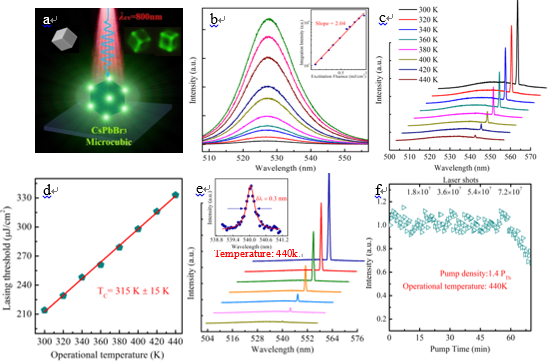Perovskite is an excellent gain medium with tightly confined sub-micrometer cavity structure, but the thermostability is a great challenge for perovskite microcavity lasers. Miniaturized high Q semiconductor nanolasers with single mode lasing output in high temperature are in high demand in physics and engineering applications, such as optoelectronic, integration, photodetectors and high-throughout sensing. However, almost all the lasing emissions from perovskite microcavities realized with optical excitation have been limited at room temperature. Achieving high-temperature lasing emission, especially single-mode lasing, is still a great challenge.
Two-photon-pumped (TPP) lasing, which provides a promising way for fulfilling frequency upconversion of coherent light without the phase-matching requirement, has received considerable attention. Perovskite nano/microcrystals with large two-photon absorption (TPA) cross-section (1.2 ×105 to 1.3 × 107 GM), bright photoluminescence (PL), and tightly confined sub-micrometer cavity structure have been demonstrated as stable TPP lasing media. However, in order to obtain TPP lasing emission, the excitation power is bound to increase greatly, which requires higher stability of the sample.
The research team from Shanghai Institute of Optics and Fine Mechanics, Chinese Academy of Sciences, together with researchers in Nanjing University of Aeronautics and Astronautics and Hunan University, has demonstrated high-temperature upconverted single-mode lasing in 3D fully inorganic perovskite microcubic cavity. The work was published on ACS Photonics.
On the basis of the 3D CsPbBr3 microcubic cavity with high crystal quality, low threshold, and great light confinement, they first improved the operational temperature to 440 K in a perovskite material system. Upconverted single-mode lasing with stable output and high quality can be obtained. The improved operational temperature tolerance of the CsPbBr3 microcubic cavity makes a step toward integrated high power density optoelectronic devices and further electrically driven lasers.
In addition, by the finite element method, the mode distributions of such a 3D CsPbBr3 microcubic cavity were analyzed systematically and clearly physical diagrams of multisets of resonances were presented. Furthermore, wavelength-tunable upconverted single-mode lasing with ultrahigh quality (8.1 × 103 to 1.01 × 104) can be achieved by changing the size of the microcavity.
This work clearly suggests that the 3D CsPbBr3 microcubic cavity with ultrahigh quality and great thermal stability can be an excellent choice for an upconverted microlaser, which would offer a new platform for integrated on-chip photonics.
These works were supported by the National Natural Science Foundation of China (NSFC) (61675219, 61875256, 61475173, 11474297, 11674343).

Two-photon-pumped high-temperature single-mode lasing characteristics (Image by SIOM)
Article website: https://pubs.acs.org.ccindex.cn/doi/10.1021/acsphotonics.9b00199
Contact:
Mr. Cao Yong
General Administrative Office
Shanghai Institute of Optics and Fine Mechanics, CAS
Email: caoyong@siom.ac.cn